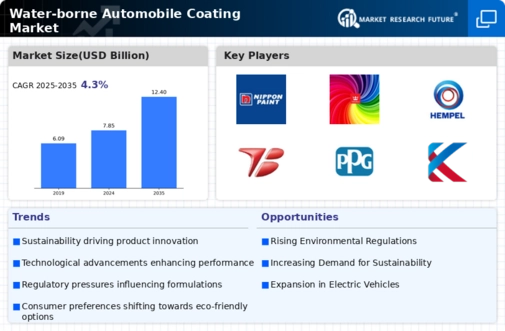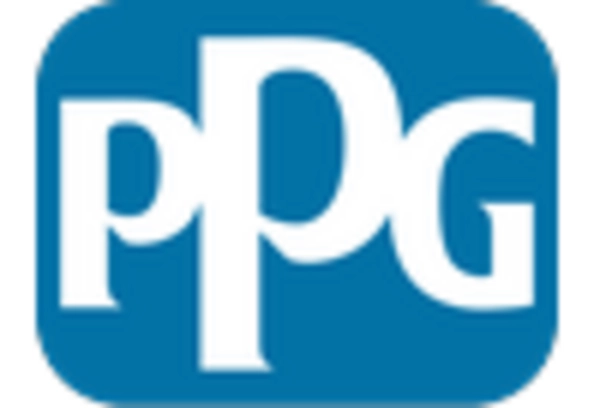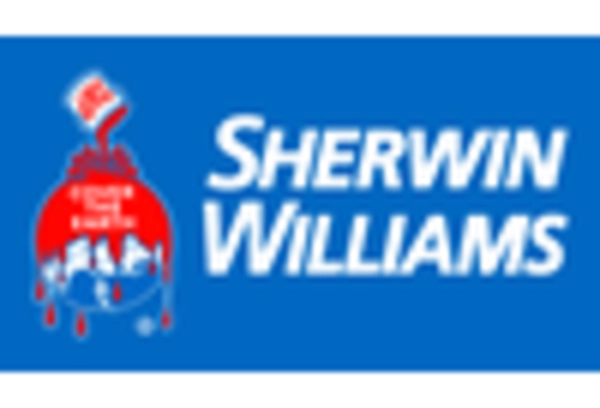Consumer Preferences
Shifting consumer preferences towards high-quality, durable, and environmentally friendly products are shaping the Water-borne Automobile Coating Market. Today's consumers are more informed and concerned about the environmental impact of their purchases, leading to a growing demand for water-borne coatings that offer lower toxicity and better performance. Market data indicates that consumers are willing to pay a premium for vehicles that utilize sustainable coatings, which is encouraging manufacturers to invest in water-borne technologies. This trend is expected to continue, as the demand for eco-friendly products rises, thereby propelling the Water-borne Automobile Coating Market forward. Manufacturers who adapt to these preferences are likely to gain a competitive edge.
Regulatory Compliance
The stringent regulatory framework surrounding volatile organic compounds (VOCs) is a critical driver for the Water-borne Automobile Coating Market. Governments worldwide are implementing regulations aimed at reducing VOC emissions, which has prompted manufacturers to transition towards water-borne coatings that comply with these standards. The market has seen a notable shift, with water-borne coatings projected to capture a larger market share as companies seek to adhere to environmental regulations. This compliance not only mitigates legal risks but also enhances brand reputation among environmentally conscious consumers. As regulations become increasingly stringent, the Water-borne Automobile Coating Market is likely to expand, driven by the need for compliant and sustainable coating solutions.
Technological Innovations
Technological advancements in coating formulations and application techniques are significantly influencing the Water-borne Automobile Coating Market. Innovations such as improved resin technologies and enhanced application methods have led to coatings that offer superior performance, durability, and aesthetic appeal. For instance, the introduction of advanced water-borne coatings with enhanced scratch resistance and UV stability has been noted to increase market demand. Furthermore, the integration of automation in the application process is streamlining production, thereby reducing costs and improving efficiency. As these technologies continue to evolve, they are expected to drive further growth in the Water-borne Automobile Coating Market, potentially leading to a more competitive landscape.
Sustainability Initiatives
The increasing emphasis on sustainability within the automotive sector appears to be a pivotal driver for the Water-borne Automobile Coating Market. As manufacturers strive to reduce their environmental footprint, water-borne coatings, which are less harmful than solvent-based alternatives, are gaining traction. This shift is evidenced by a reported increase in the adoption of eco-friendly materials, with water-borne coatings expected to account for a substantial share of the market by 2026. The growing consumer preference for sustainable products further propels this trend, as buyers are more inclined to choose vehicles that utilize environmentally responsible coatings. Consequently, the Water-borne Automobile Coating Market is likely to experience robust growth as manufacturers align their offerings with sustainability goals.
Market Expansion Opportunities
The Water-borne Automobile Coating Market is poised for expansion due to emerging markets and increasing automotive production. As developing regions experience economic growth, the demand for automobiles is rising, leading to a corresponding increase in the need for effective coating solutions. Market analysts project that the Asia-Pacific region will witness significant growth in automotive production, which will, in turn, drive the demand for water-borne coatings. Additionally, the trend towards electric vehicles, which often utilize advanced coatings for enhanced performance, presents further opportunities for market growth. As manufacturers seek to capitalize on these trends, the Water-borne Automobile Coating Market is likely to see substantial advancements and increased market penetration.


















Leave a Comment